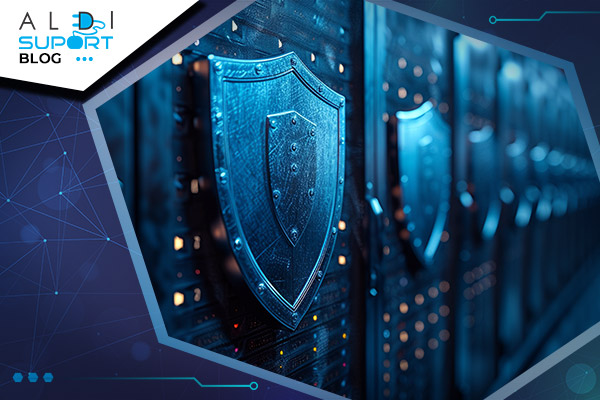Network security is crucial for protecting sensitive information and ensuring the uninterrupted operation of your IT infrastructure. In this article, we’ll explore the importance of network security, setting up firewalls and intrusion prevention systems (IPS), implementing user and access security policies, and methods for monitoring and detecting suspicious network activities.
The Importance of Network Security in a Business Environment
Risks Associated with Poor Network Security
An unsecured network can expose an organization to various risks, including cyberattacks, data loss, and service disruptions. Cyberattacks such as phishing, malware, and DDoS attacks can compromise sensitive data and cause significant financial and reputational damage.
Benefits of a Secure Network
A secure network ensures:
- Protection of Sensitive Data: Prevents unauthorized access to critical information.
- Business Continuity: Minimizes the risk of disruptions and data loss.
- Regulatory Compliance: Helps meet security standards and regulations.
Notable Examples of Cyberattacks
Notable examples of cyberattacks include the WannaCry attack in 2017, which affected thousands of organizations worldwide, and the Equifax security breach in 2017, which compromised the personal information of over 147 million people.
Configuring Firewalls and Intrusion Prevention Systems (IPS)
What Are Firewalls and How Do They Work?
Firewalls are devices or software that monitor and control network traffic, blocking unauthorized access while allowing trusted traffic. They operate based on predefined rules and can filter traffic by IP addresses, ports, and protocols.
Types of Firewalls
There are several types of firewalls, including:
- Network Firewalls: Protect the entire network.
- Personal Firewalls: Protect individual devices.
- Hardware vs. Software Firewalls: Hardware firewalls are physical devices, while software firewalls are applications running on servers or computers.
Configuring Firewalls
Setting up a firewall involves:
- Establishing Filtering Rules: Define what types of traffic are allowed or blocked.
- Monitoring Traffic: Use logging to track network activity.
- Updating Rules: Regularly review and adjust firewall rules to address new threats.
What Are Intrusion Prevention Systems (IPS) and How Do They Work?
Intrusion Prevention Systems (IPS) monitor network traffic to detect and prevent suspicious activities. They work by analyzing data packets and comparing them to known attack signatures.
Implementing an IPS
Steps for implementing an IPS include:
- Selecting an IPS: Choose a system that fits your network needs.
- Configuring Rules and Policies: Define what types of activities should be monitored and blocked.
- Monitoring and Maintenance: Continuously monitor network activity and adjust IPS rules based on new threats.
Implementing User and Access Security Policies
Password Policies
Passwords are the first line of defense against unauthorized access. Implementing strong password policies involves:
- Password Complexity: Require users to use complex passwords with uppercase and lowercase letters, numbers, and symbols.
- Regular Password Changes: Prompt users to change their passwords regularly.
- Multi-Factor Authentication (MFA): Adding MFA provides an extra layer of security by requiring users to provide two or more forms of identification.
Access Policies
Access policies define who can access network resources and under what conditions. These can include:
- Role-Based Access Control (RBAC): Assign permissions to users based on their roles within the organization.
- Segregation of Access Rights: Limit user access to only the resources necessary for their tasks.
- Access Monitoring: Use access logs to track user activity and detect unusual behavior.
Acceptable Use Policies
Acceptable use policies define how IT resources can be appropriately used by employees. These may include:
- Internet Usage Restrictions: Limiting access to potentially dangerous websites.
- Software Download and Installation Policies: Prohibiting the download and installation of unauthorized software.
Methods for Monitoring and Detecting Suspicious Activities in the Network
Using Network Monitoring Software
Network monitoring software helps identify suspicious activities and manage network performance. These tools include:
- Wireshark: A packet analysis tool that allows detailed inspection of network traffic.
- Nagios: A network and server monitoring software that provides alerts and detailed reports.
- SolarWinds: A suite of network management tools that includes performance monitoring and anomaly detection.
Implementing an Intrusion Detection System (IDS)
Intrusion Detection Systems (IDS) monitor network traffic to detect suspicious activities. IDS can be:
- Signature-Based: Detects known attacks by comparing traffic to known attack signatures.
- Anomaly-Based: Detects unusual behaviors that may indicate an attack.
Event Log Analysis
Event logs record network activities and can be used to detect and investigate security incidents. Analyzing these logs involves:
- Collecting and Centralizing Logs: Use a centralized system to collect logs from all network devices.
- Data Analysis and Correlation: Use analysis tools to correlate events and detect patterns of suspicious behavior.
- Alerting and Reporting: Set up alerts to be notified of suspicious activity and generate regular reports.
Maintaining and Updating Security Measures
Importance of Security Updates
Keeping equipment and software up to date is essential for protecting the network against new vulnerabilities and attacks. Security updates include software and firmware patches that address security issues.
Implementing an Update Plan
An effective update plan should include:
- Vulnerability Assessment: Identify and assess existing vulnerabilities in the network.
- Update Planning: Establish an update schedule that minimizes operational impact.
- Update Testing: Test updates in a controlled environment before deployment.
- Update Deployment: Roll out updates across all network devices.
Data Backup and Recovery
A solid backup plan ensures that data can be recovered in case of an attack or failure. Backup types include:
- Full Backup: Saves all data at a single point in time.
- Incremental Backup: Saves only the data that has changed since the last backup.
- Differential Backup: Saves all data that has changed since the last full backup.
Testing Security Plans
Regularly testing security plans is crucial to ensure they work as expected. This can include:
- Attack Simulations: Conduct penetration tests to identify vulnerabilities.
- Policy Review and Update: Periodically review security policies to address new threats.
Conclusion
Network security is essential for protecting data and ensuring business continuity. By implementing appropriate security measures, such as firewalls, IPS, and access policies, you can reduce the risk of cyberattacks and safeguard your IT infrastructure.
Network Security with Aldi Suport
For professional solutions and specialized support in network security, trust Aldi Suport. Our team of experts offers comprehensive services for firewall configuration, IPS implementation, and security policy consultation. Protect your business with the help of professionals at Aldi Suport.
Frequently Asked Questions
What is a firewall and how does it work?
A firewall is a device or software that monitors and controls network traffic, blocking unauthorized access while allowing trusted traffic based on predefined rules.
What are the benefits of using an IPS?
An Intrusion Prevention System (IPS) detects and prevents suspicious activities in the network, helping to protect against cyberattacks and unauthorized access.
How can I implement effective security policies for users?
User security policies include password rules, role-based access control, and acceptable use policies. These help protect network resources and prevent unauthorized access.
What tools can I use to monitor suspicious activities in the network?
Popular network monitoring tools include Wireshark for packet analysis, Nagios for server monitoring, and SolarWinds for network performance management.
Why is it important to keep equipment and software updated?
Security updates are essential for fixing vulnerabilities and protecting the network against new cyberattacks. Keeping equipment and software updated helps prevent security breaches.
What is a backup plan and why is it important?
A backup plan ensures that data can be recovered in case of an attack or failure. Backup types include full, incremental, and differential, each protecting data in a specific way.





